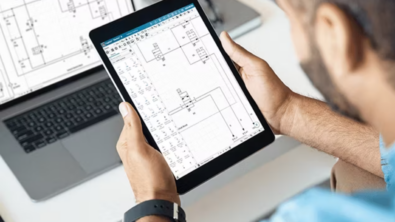Making data access secure and simple for rapid aerospace E/E system design

When digital transformation is the primary goal for an aerospace OEM, a lot is at stake. Especially when it comes to aerospace E/E system design, implementing new processes is costly, involving mandatory training and ramp-up time that can chip away at the overall budget. Additionally, compliance regulations are increasingly strict and avoiding the risk of a data breach is of paramount importance. In 2021, cyberattacks and data breaches increased by 15% from the previous year.
But transforming processes with data and automation is essential to achieving the performance benchmarks required of today’s modern aerospace products, because it allows for more effective collaboration and design iterations that lead to innovation. And, it enables OEMs to overcome the various challenges the industry’s facing, including tight schedules, budget constraints, increasing electrification, and intense competition. How do we get there?
Model-based design.
More and more organizations are incorporating a model-based approach into their E/E design and manufacturing process. Valued at over $9 billion in 2020, the Model-based enterprise market is expected to reach $29 billion by 2027, growing at a CAGR of 18%. Siemens Capital software provides a comprehensive, model-based E/E systems development solution, addressing the need for data privacy with advanced authorization and authentication capabilities.
Let’s take a look at how one leading aerospace OEM leveraged Capital and its model-based approach – as well as the advanced authorization and authentication capabilities of Capital – to provide global design teams secure access to design data, improving collaboration and resulting in faster time to market with next-generation Aerospace products.
The power of the digital twin
The model-based system design capabilities of Capital enabled the client’s design team to create a digital twin – a virtual representation of the physical E/E system that can be used for collaboration, simulation, integration testing, monitoring and maintenance. The client’s team can import design requirements, system models and constraints into the design environment and output data to inform other disciplines such as distribution, software and networks. All of this information is delivered in the context of the mechanical environment, and can be connected with downstream tools to support manufacturing and operational processes.
Meanwhile, Capital simplifies data access control and security with advanced authentication and authorization capabilities:
- Authentication verifies the user identity and keeps data secure by permitting only genuine users to access protective resources such as databases, websites, and networked applications.
- Authorization is a security mechanism used to determine user privileges or access levels related to system resources, including data and application features.
The tool’s authorization model enables teams to control permissions, domains and change policies, and authorize users to access specific data, while keeping other data off-limits. Access is configured based on a user’s role or identity, and Capital even allows teams to implement additional safeguards such as password aging. These capabilities ensure the right users have access to all of the data they need – and only the data they need – reducing risk while supporting collaboration and rapid time to market.
Secure data access for global teams
With the ability to automate granular access controls to the full set of design data, Capital has enabled the client to better support its global design teams while meeting diverse and increasingly stringent requirements and global compliance rules around data privacy. Through its advanced authorization and authentication capabilities, the arduous task of exporting controlled data is drastically simplified, eliminating complexity from the design workflow and removing a formidable barrier to effective E/E systems design.
To learn more about how MBSE in aerospace E/E systems design leads to fewer errors and faster design iterations, accelerating program completion, read the whitepaper: System driven electrical, electronics, network and software design for aerospace.
Watch this webinar to understand the power of transforming your service and maintenance output to gain the control to minimize risk and take a step closer to maintenance efficiency: Reducing aircraft operating costs.
To learn how a large aerospace OEM uses Capital to reduce data access complexity for aircraft E/E system design, download our white paper on how to Reduce data complexity for aircraft E/E system design now!
You can also learn more about the Siemens solutions for Aerospace and Defense here.


